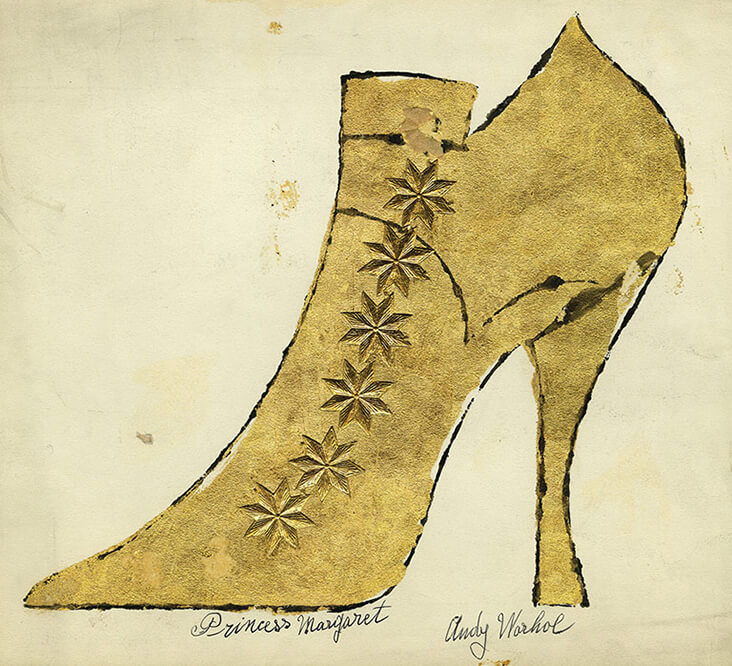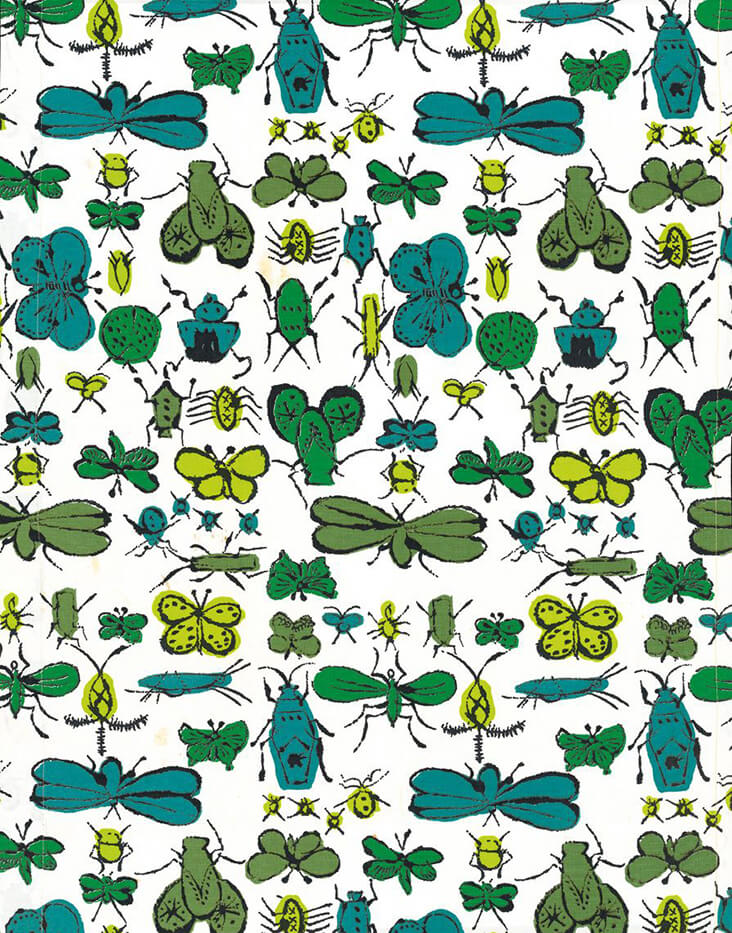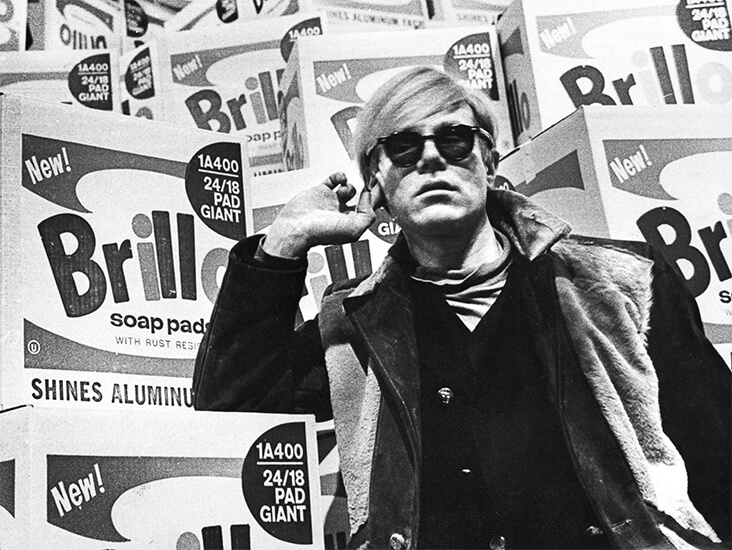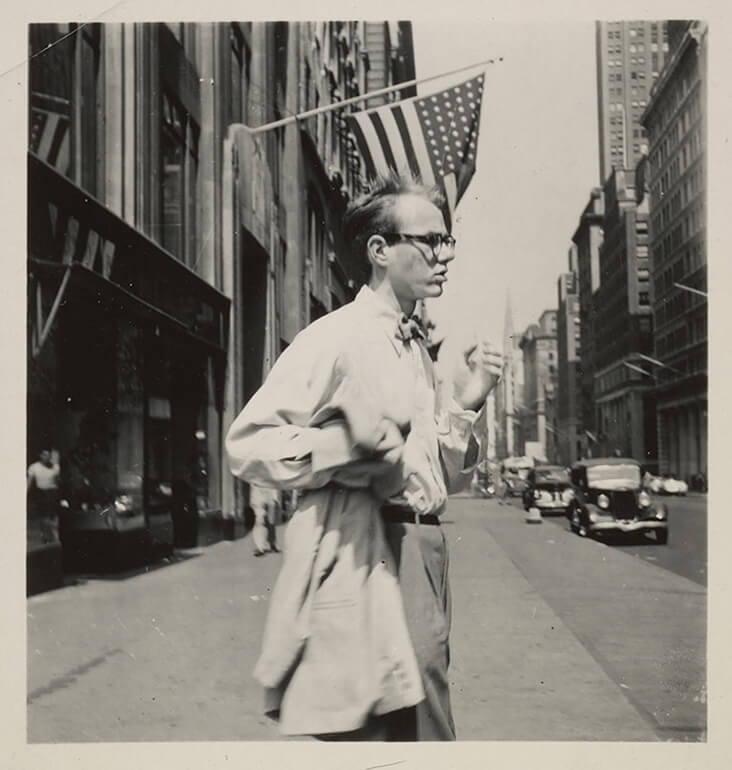Andy Warhol Fashion of the 1960s

Andy Warhol shoe illustration for I. Miller and the New York Times, featuring ornate cloth patterning, 1950s
Andy Warhol is the undisputed king of American Pop Art, creating some of the world's near iconic and emblematic works of fine art. Multiples, seriality and repetition were key themes in his art – think Campbell's Soup Cans or Marilyn'south face – then mayhap it's no surprise that among his many creative ventures he turned his hand to printed textiles. Much like his art, Warhol brought the symbols of 1950s and 60s Americana into his fabric patterns, creating playful, whimsical and vibrant designs that gloat the lighter, more than frivolous side of life in America, from indulgent ice-cream sundaes to day-glo butterflies, colourful buttons and blooming flowers. Every bit his career grew, Warhol also demonstrated a love of fabric by transforming himself into a fashion icon, ane that is now forever bound to life in 1960s New York.

Andy Warhol shoe analogy for I. Miller and the New York Times, featuring ornate fabric patterning, 1950s
Warhol's creative career began as a freelance illustrator for a number of leading manner and lifestyle magazines in New York Urban center. His early on illustrations demonstrated but how much he adored mode, specially the drawings he made in collaboration with the celebrity shoe designer I. Miller, which featured in the weekly Sun supplement of the New York Times. Made with graphic black lines and adorned in indulgent patterns and colours, they revealed Warhol'southward fascination in the way patterns and habiliment could lift one above the ordinary and into a fantasy realm.

Andy Warhol'due south 'Happy Bug Da' textile print for Fuller Material in the 1950s
As his reputation gradually grew, Warhol's repertoire expanded far beyond illustration into a wide puddle of disciplines including printmaking, photography, film and more. He was famously indiscriminate, never turning downwards an opportunity to work with someone new, and this mental attitude paid off well, earning Warhol a wide social circumvolve of contacts and friends across the metropolis. From the 1950s onwards Warhol designed a series of repeat print textiles for Fuller Fabrics which echoed the playful, whimsical quality of his illustrations, with quirky line drawings of everyday ephemera that seemed to capture and celebrate the spirit of the times, including food, household objects, flowers, insects and animals, coloured with his trademark, eye-catching artificial hues.

Andy Warhol and Campbell's Soup'due south 'Souper Wearing apparel', 1960s
Fifty-fifty in the 1960s when Warhol's career as a Pop artist was gathering pace, he still turned his hand to mode, famously reproducing his iconic Campbells Soup Cans onto paper dresses which became highly desirable among New York's socialites. Campbell's Soup even picked up on the publicity, creating their own 'Souper Dresses' (made in an 80/xx blend of cellulose and cotton wool) featuring Warhol'southward design, which anyone could buy for $1 and 2 soup labels. Unsurprisingly these are at present collector'southward items that can sell for anything between $5,500 to $25,000.

Andy Warhol with his Brillo Boxes motifs, photographed in 1968
Throughout the 1960s Warhol began cultivating his own image, and his inimitable style is as instantly recognisable today as it was in his heyday – that of nighttime sunglasses, white blonde/silvery hair, black and white clothes, smart jackets and jeans. He took this style with him to the glittering parties he frequented across New York Metropolis, including the star-studded nights at Studio 54, and his trademark look became its own form of branding, helping him sell himself as a article in an increasingly commercial world. In 1969 Warhol further deepened his connexion to style past founding Interview magazine, which regularly printed articles and interview on leading designers.

Andy Warhol in New York Urban center, c 1949, Philip Pearlstein
Since the 1960s, Warhol'southward voice has perpetually infiltrated the fashion world, through his multi-aqueduct work every bit a fabric designer, artist and fashion icon. In the 1980s, French fashion designer Jean Charles de Castelbajac paid tribute to Warhol with a riff on the 'Souper Wearing apparel', creating a apparel shaped and decorated like a Campbell's Soup Can. Merely a few years later, Italian designer Gianni Versace made a dress printed with Warhol's famous Marilyn motif every bit a assuming repeat pattern. More recently, it is perhaps Warhol's own make that has endured the test of time – in 2014, Danish fashion designer Peter Jensen styled his runway models to look like Warhol, with monochrome outfits, dark glasses and curt silvery pilus, and he is just one of many who go along to replicate Warhol's manner. All this afffirms that Warhol's image lives on today, not just for its effortlessly cool vibe, simply the way it encapsulated the spirit of the time in which he was living, a hedonistic era of glamour, indulgence and escapist fantasy.
0 Response to "Andy Warhol Fashion of the 1960s"
Post a Comment